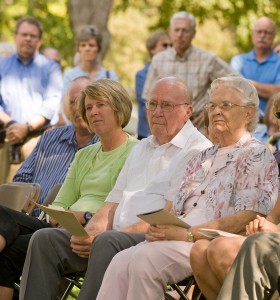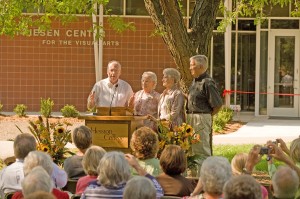
During a warm and sunny fall afternoon, an estimated 250 people gathered in a shaded lawn area on the Hesston College campus to dedicate the new Friesen Center for the Visual Arts. At the end of the dedication service Saturday, September 27, Norm Yoder, chair of the Hesston College Board of Overseers, joined Paul and Wilma Friesen in a ribbon-cutting ceremony for the new facility.
The Friesen Center for the Visual Arts honors the contributions of the Friesens to the Art Department and to the college in general. Art Department faculty and students began using the $2 million building when fall classes began August 25. Located between Northlawn (music and theatre) and Charles Hall (the sciences), the Friesen Center provides a state-of-the art facility, with teaching space for ceramics, painting, print-making, and drawing; new gas and electric kilns; a computer lab for graphic design and digital photography; an art gallery; faculty offices, and a sculpture studio for Paul Friesen, faculty emeritus in art.
During opening remarks, President Howard Keim noted that Paul Friesen’s art work is unsurpassed by any other Mennonite artist. In addition, he said, “Paul is leaving a legacy of students and now students of his students who will carry his skill, creativity, and spirituality for generations to come.”
Keim said the Friesen Center for the Visual Arts is more than a monument or tribute. “It is a place where the God-given and spirit-inspired creativity will be nurtured in students,” he said. “It is a place where artists will display their work and interact with students, where faculty will teach appreciation for visual art and the techniques of various forms. It is a place where the next generation of artists will be prepared to take their places in studios, schools, and churches around the world. This facility will strengthen our efforts to help all students gain appreciation and skill of the visual arts for service.”
Friesen founded the Art Department, teaching the first class in what had previously been the potato cellar in the basement of Green Gables during the spring semester of 1957. The Art Department moved to different locations over the years until 1969, where it operated in the basement of Erb Hall until classes began this fall in the new Friesen Center for the Visual Arts.
Former faculty members John Blosser and Robert Regier recounted some of the Art Department history. Blosser became chair of the department in 1978, when Friesen retired from Hesston College. He recalled that when he came to the college, Friesen helped him tool up to teach ceramics. “I had taught design, drawing, and painting, but not ceramics,” he said. “So I spent two wonderful weeks one summer learning to throw clay, pull handles, and so on.
“Products were modest,” Blosser continued, “but it was the start of a wonderful 15 years of teaching ceramics. Paul was always a visiting artist for my ceramics classes.
“Paul, you’re an inspiration to me,” Blosser said, “You’ve been a disciplined artist. But [you have] always been pastor first. Many people have sat at his potter’s wheel and spilled their heart out to him. In many ways, he sees himself as pastor first and artist second. But I know few people who so well integrate the two. That blending of art and faith seems so natural to you.”
Blosser, who was Art Department chair and taught at Hesston College from 1978 to 1999, now chairs the art department at Goshen (Ind.) College.
Regier, professor emeritus of art at nearby Bethel College, North Newton, Kan., collaborated with Friesen so that both professors taught art classes at Bethel College and Hesston College from 1965 to 1978.
“I have so many rich memories of working with Paul,” Regier said. “We were friends, sharing our family life as well as our professional life. What I remember most about Paul is that he would always go the extra mile to make sure that my experience here on the Hesston campus was the best possible experience. His enthusiasm for teaching was contagious. His spiritual moorings are sound. My life has been, and continues to be, enriched by my friendship with Paul. It’s a privilege to participate in this milestone event today.”
Three former students of Friesen at Hesston College who are artists today-Phil Hershberger ’73, Topeka, Kan.; Marena (Leichty) ’01 Nachtigal, Kalona, Iowa; and Brittni Wegmann ’03, Tallahassee, Fla.-shared words of appreciation.
Hershberger recalled that at Hesston College, “we were all taught through image, words, and action that there was no disconnect between our faith traditions and the pursuit of the visual arts. It is a thrill to be present at this event. We have finally come into the daylight. Now one only has to step onto campus to recognize that the visual arts are an important and integral part of the Hesston College curriculum and culture. I want to add my thanks to Paul and Wilma for making this possible.”
Nachtigal said her only classroom experience with Paul Friesen was an advanced wheel throwing class that she took. “I think all of us in that classroom realized that this was a man who had a wealth of knowledge about clay and about life, and that he was excited to share it with us,” she said.
“I’ve always been amazed and grateful that Paul saw something in me that he thought should be encouraged,” Nachtigal continued. “Mentor doesn’t really come close to describing what Paul’s legacy to me has been. The amazing thing about Paul is that mine is just one of many lives he has impacted through his service at Hesston College.”
For Wegmann, she took her first ceramics class with Friesen in 2002. “It was my first experience with the potter’s wheel,” she said, “and Paul’s hands-on teaching method gave me greater understanding and excitement for the possibilities clay offers and made me want to continue.”
Wegmann recalled when she returned to Hesston College in 2005 as its first artist-in-residence in ceramics, “Paul made himself available as a mentor and teacher,” she said. “He always had something to share with me, from clay, or about teaching, or what was going on in life. Looking back now as I’m in [graduate] school and teaching again, I realize that if it weren’t for Paul’s influence in my life, I wouldn’t be where I am today.”
Kelvin Friesen, Archbold, Ohio, the oldest of Paul and Wilma Friesen’s six children, read II Corinthians 4:6-10, a Scripture chosen by Paul Friesen. Then Kelvin added, “This Friesen Center for the Visual Arts will be a great addition to the experience that makes Hesston College such a special place to the many students who pass through it. I’d like to take this opportunity on behalf of our family, and my brothers and sisters and their families, to express appreciation to the many people, the administration, the faculty and staff, the Board of Overseers, and the many generous donors, for honoring Mom and Dad in this way.”
Lois Misegadis, chair of the Art Department, said she was pleased 10 years ago to come to a college where an art program was well-established, “valued and supported in large part by the work of John Blosser, Bob (Robert) Regier, and Paul Friesen, along with a host of students, alumni, faculty, staff, and supporters of all kinds,” she said.
“This campus is truly blessed by its reverence for the arts and how arts do carry with it the spirit of the Lord,” Misegadis went on. “It’s even a greater pleasure to stand in front of this building, so that today we can pay tribute to Paul Friesen and Wilma for their work to establish the arts here at Hesston College and in the church at large.”
In his response, Paul Friesen said that he and Wilma appreciate the honor extended to them. But, he emphasized, “This honor belongs to all of you-you who have sent your children, who’ve come as students, or who’ve come to the college as friends to contribute and to share in the promotion of a Christian academic program for the church. And we say, thank you.”

Friesen also acknowledged Wilma and paid tribute to her. “I give her a tremendous amount of credit for the things she had to put up with and the things she had to do,” he said. “In spite of all of that, she continually gave me encouragement.”
He also acknowledged their six children-Kelvin, Jan Roth West, Gregg, Eric, Jon, and Jennifer LeFevre-along with extended family members and friends present for the dedication. Friesens have 12 grandchildren and one great-grandchild.
Friesen gave a prayer of dedication, followed by the ribbon-cutting ceremony which officially opened the Friesen Center for the Visual Arts.
After the ribbon-cutting, the Friesens welcomed people to the Friesen Center as they entered for an open house and reception. A retrospective art exhibit of ceramics and sculptures by Paul Friesen is featured in the facility’s Student Gallery. The exhibit will be open until October 22. Hours are 9 a.m. to 4 p.m. Monday through Friday.
Sophomore art major Tessa Walters, Salina, Kan., says she was in awe of the Friesen Center when she first walked through the building earlier this fall. “I love the big windows in the drawing room and the lighting in the entire building,” she said. “It’s a nice change from the basement of Erb Hall, which was so dark and gloomy. It’s neat to have new equipment, computers, tables, and kilns, and to be the first to use it. It inspires me to be more artistic, since it’s a new place and a new atmosphere.”
“The quality of light and the volume of space in the new Friesen Center for the Visual Arts opens one’s mind to creative possibilities,” said Lois Misegadis, chair of the Art department. “Students, freshmen and sophomores alike, are nearly giddy with excitement. They are grateful for the ‘awesome lighting’ and how modern and clean the new facility is.
“It’s rare,” she continued, “for a college to build such a wonderful facility for the visual arts.”

